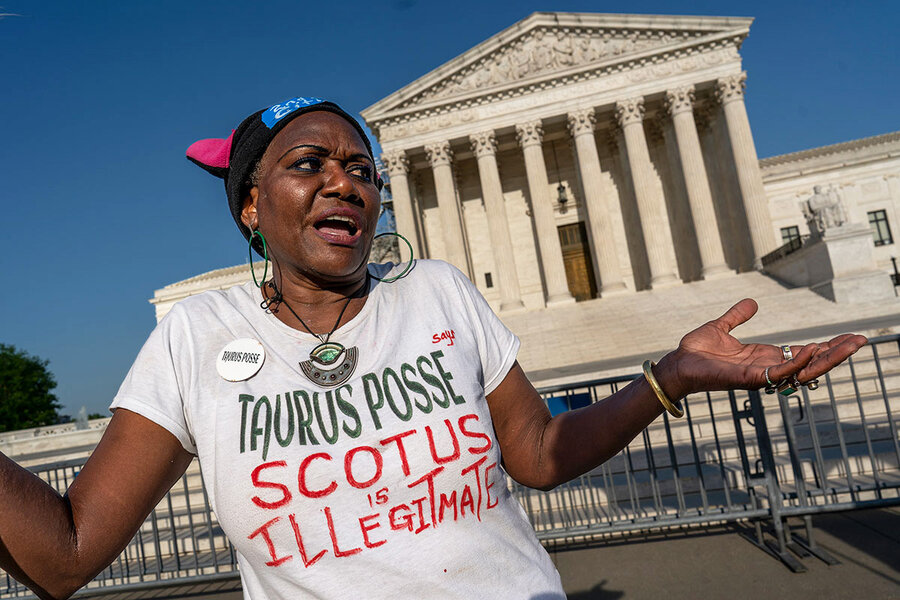Supreme Court pushed abortion to states. A year later, it’s back.
Loading...
The U.S. Supreme Court this week agreed to hear an abortion case for the first time since overturning a constitutional right to abortion last year.
The case, which concerns the federal approval of the widely prescribed pill mifepristone, comes at a time when abortion access is being fiercely litigated across the United States. Voters in states such as Kansas, Michigan, and Ohio have voted to preserve access, while state courts in places like Texas, where near-total bans have been implemented, remain loath to approve medical exceptions. The drug is used in more than half of all abortions, and a ban would complicate access for women in states where the procedure remains legal.
A decision in the case is expected next summer, just months before a presidential election where abortion is expected to be a major issue for voters.
Why We Wrote This
The Supreme Court overturned women’s constitutional right to an abortion and said it was up to the states to decide legality. A year later, the issue is headed back to the high court.
Mifepristone has been publicly available since 2000, when it was first approved by the U.S. Food and Drug Administration. The agency has made the drug more accessible since then, issuing new regulations in 2016 and 2021. A coalition of anti-abortion groups and doctors filed a lawsuit in Texas earlier this year, seeking to pull the medication off the shelves. The approval processes for mifepristone were flawed, they argue, and the drug is too dangerous to be kept on the market.
The FDA and the manufacturer of mifepristone dispute these arguments in the case FDA v. Alliance for Hippocratic Medicine. In April, a conservative district court judge blocked all FDA approvals of the medication. In August, the U.S. Court of Appeals for the Fifth Circuit largely overturned that order but reinstated the agency’s pre-2016 restrictions on mifepristone, such as requiring an in-person visit.
After the district court ruling, the Supreme Court issued an emergency order that kept the drug publicly available. This week, the court also declined to take up a challenge to the FDA’s initial approval of mifepristone in 2000. Both actions “augur badly for the Alliance for Hippocratic Medicine,” says Mary Ziegler, a professor at the University of California, Davis School of Law.
“We know a majority of the justices are skeptical about something with the case,” she adds.
This means that however the court ultimately rules, there most likely won’t be the overnight change the country felt after Dobbs v. Jackson Women’s Health Organization. Mifepristone will likely stay on the market, but if the justices uphold the Fifth Circuit ruling, the medication would become more difficult to access. A win for the Alliance for Hippocratic Medicine, meanwhile, would have the potential to transform how the U.S. regulates medical care and prescription drugs.
Since 2016, the FDA lifted the requirement that patients make an in-person visit to get a prescription. It also allowed nurse practitioners to prescribe the drug. Mifepristone is now used in more than half of all medication abortions in the U.S., according to a survey from the Guttmacher Institute. Researchers also consider it one of the safest methods for managing miscarriages early in pregnancy.
The Supreme Court will first have to decide if the lawsuit can be brought at all. This standing issue – which boils down to whether a party has been harmed enough to justify taking legal action – has been controversial from the beginning. The anti-abortion groups and doctors claim that, because mifepristone can lead to life-threatening medical complications they may have to deal with in emergency rooms, the physicians have suffered the necessary harm to meet requirements.
A study by the FDA found that there were 5 deaths associated with mifepristone for every 1 million people who have been prescribed it since 2000. That compares with 20 deaths per 1 million for penicillin, a widely prescribed antibiotic, the FDA pointed out in its amicus brief.
“This is an incredibly attenuated theory of standing,” says Laura Portuondo, an assistant professor at the University of Houston Law Center. “If [it] works, there’s no drug that you couldn’t have standing to sue against.”
If nothing else, the case drives home the fact that the Supreme Court’s declaration in Dobbs that the issue would now be returned “to the people and their elected representatives” in states has not come to pass. “Dobbs did not get the Supreme Court out of the business of abortion,” says Kimberly Mutcherson, a professor at Rutgers Law School, in an email. “There are so many issues that remain to be resolved under the federal constitution.”
And with abortion restrictions proving unpopular with a majority of American voters, including in red states, courts will likely remain a popular forum for those hoping to restrict abortion access further.
Another big change is that women, including women who want more children such as Kate Cox in Texas, are going public with deeply personal stories of being denied miscarriage care and being denied emergency medical exemptions, even though lack of treatment threatens their health and fertility.
“We’re seeing stories of abortion inside and outside of court being told by women,” Professor Ziegler says. “We’ll see more of that, and ... that’s very different from the pre-Dobbs landscape.”
While the mifepristone case is the first big abortion case since Dobbs, it is unlikely to be the last – no matter how the justices decide.
“Whatever the court does means more kinds of cases like this are going to show up, it’s just a matter of what kinds of cases,” says Professor Ziegler.
The standing issue “is a perfect off-ramp if they don’t want to deal with this,” she adds. And “they might not want to have a big abortion [ruling] right before the election.”






